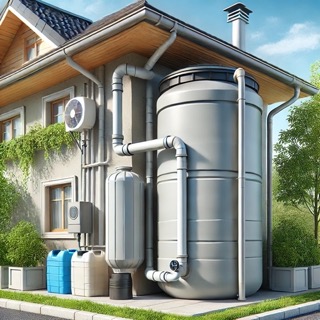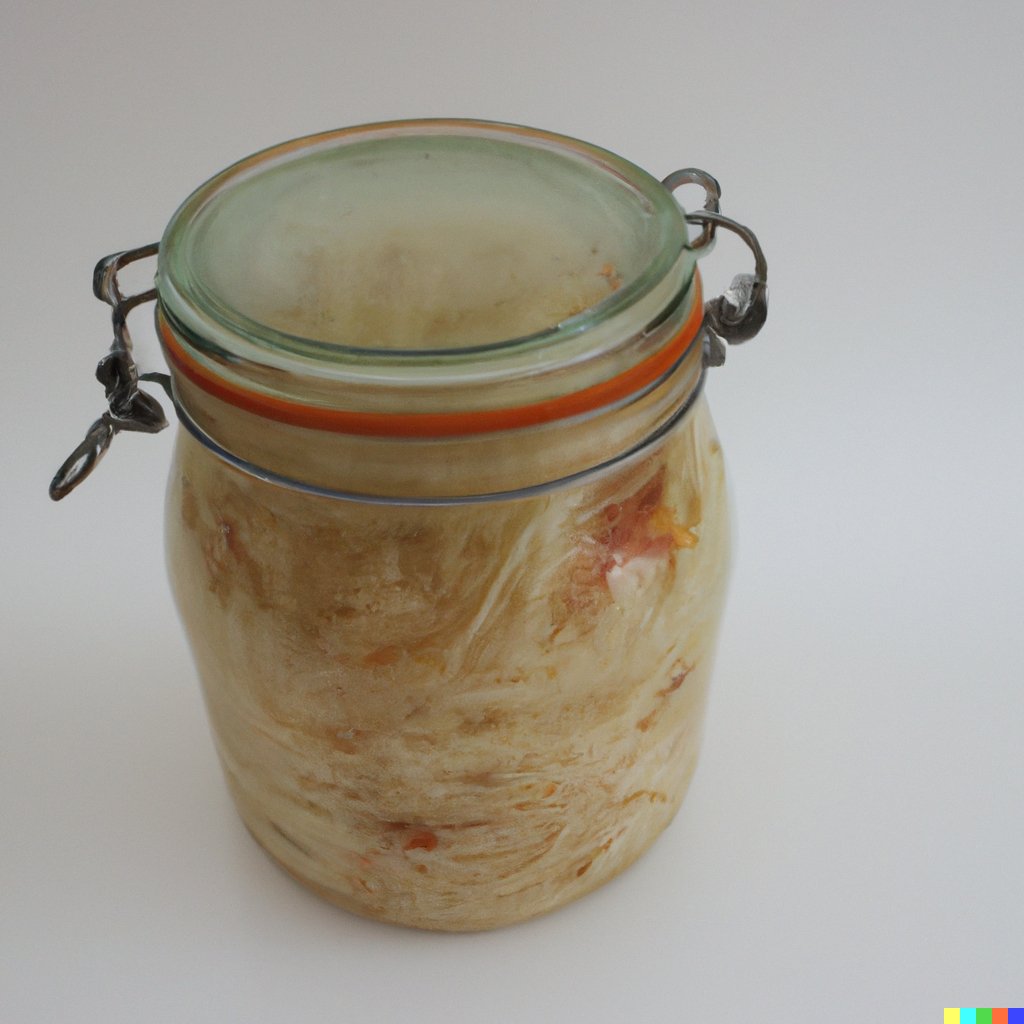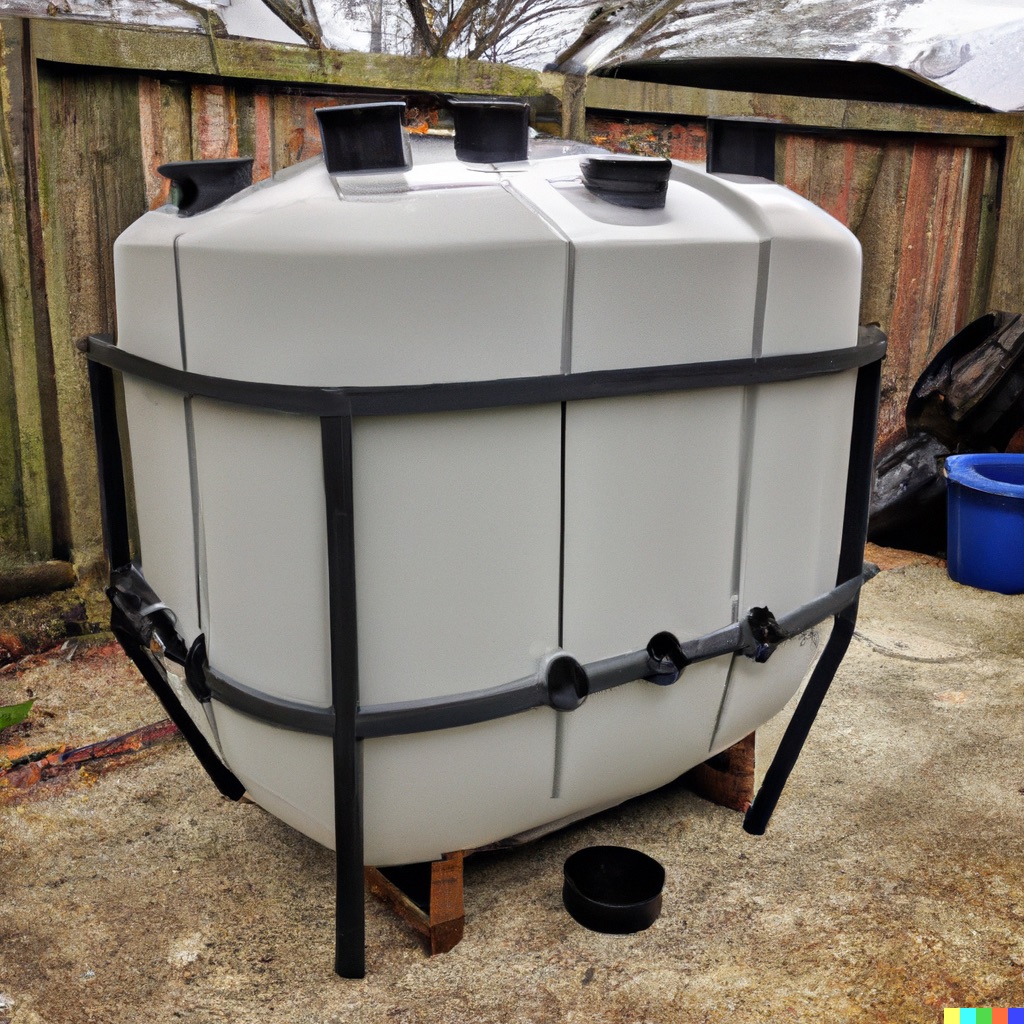
Harnessing the power of rainwater has never been easier, thanks to the rising popularity of IBC totes. These industrial containers, when repurposed, offer families an eco-friendly, cost-effective, and health-conscious solution for rainwater harvesting. Dive in to discover how IBC tote rain collection is making waves in environmental protection, sustainability, and health.
Best Bang per Buck: Used / Refurbished IBC Container in your area
*As an eBay Affiliate, I earn commission from qualifying purchases made through links in this post.*
| Product | Link | Price ($) | Capacity (Gallons/ Liter) | Price per Gallon ($) | Location |
| 275 Gallon IBC Tote - Water Tank | https://ebay.us/l3FSAU | 100.00$ | 275 Gallons/ 1040 Liter | 0.36$ | New York |
| 275 Gallon IBC Tote - Water Tank | https://ebay.us/fGD7Tr | 99.00$ | 275 Gallons/ 1040 Liter | 0.36$ | California |
| 275 Gallon IBC Tote - Water Tank - CONTACT FOR SHIPPING QUOTES | https://ebay.us/Zr35Pd | 150.00$ | 275 Gallons/ 1040 Liter | 0.55$ | Pennsylvania |
| USED 275 Gallon IBC Tote / Fluid Container Schuetz IBC275GAL | https://ebay.us/j75gKx | 99.00$ | 275 Gallons/ 1040 Liter | 0.36$ | California |
| IBC Tote Cove, 275 Gallon IBC Water Storage Barrel Liner Bags | https://ebay.us/VRXcC0 | 122.99$ | 275 Gallons/ 1040 Liter | 0.45$ | Florida |
| IBC Tote Cove, 275 Gallon IBC Water Storage Barrel Liner Bags | https://ebay.us/FCgmdS | 73.09$ | 275 Gallons/ 1040 Liter | 0.27$ | Alabama |
| 330 Gallon IBC Tote Tank | https://ebay.us/Cs8AOU | 250.00$ | 330 Gallons/ 1250 Liter | 0.76$ | Ohio |
*As an Amazon Associate, I earn commission from qualifying purchases made through links in this post.*
| Product | Volume | Measures LxWxH |
Price - September 2024
|
Price per Gallon
|
| 275 Gallon IBC Tote with Metal Pallet & Cage https://amzn.to/3AvYUar |
275 Gallon 1040 Liters |
47.5x39.5x45.5 inches 120x100x115 cm |
621.22$ | 2.26$ |
| Global Industrial IBC Container 275 Gallon UN Approved w/Composite Metal Pallet Base https://amzn.to/4ehb2db |
275 Gallon 1040 Liters |
47.5x39.5x45.5 inches 120x100x115 cm |
730.13$ | 2.66$ |
| IBC Tank 330 Gallon for Water or Liquid Storage and Dispensing, HDPE Tank Surrounded by a Galvanized Steel cage https://amzn.to/3YrSmBP |
330 Gallon 1250 Liters |
48x40x53 inches 122x102x134 cm |
1450.00$ | 4.39$ |
1. Why IBC Totes for Rain Collection?
IBC totes, once used for industrial purposes, are now the go-to choice for many households keen on rainwater collection. But why?
Cost-Effective and Durable
Buying used IBC totes directly from local manufacturers doesn't just save money; it's a nod to sustainability. These totes, designed for transport, are incredibly sturdy, ensuring they stand the test of time. Even in the harshest of winters, they can withstand pressures up to 14 psi.
Are you looking for the best rain collection tanks to purchase? Maybe this guide can help you.
Prioritizing Health and Safety
When it comes to our family's health, we leave no stone unturned. Opting for IBC totes that previously stored food-grade liquids ensures the collected rainwater remains uncontaminated. This makes it a safer alternative to the often chemically-treated municipal water.
Design, Efficiency, and Lazy Sustainability
The design of IBC totes is a marvel in itself. Their space-efficient form factor is perfect for both sprawling gardens and compact urban spaces. And the best part? Their standard fittings allow for unlimited expandability. Setting up and maintaining an IBC tote system is so straightforward, it's the epitome of lazy sustainability.
2. Benefits of IBC Tote Rain Collection
IBC totes are revolutionizing the way families approach rainwater harvesting. Their benefits span from environmental conservation to health and financial savings.
Environmental Impact of IBC Tote Rain Collection
Harnessing rainwater through IBC totes directly conserves municipal water resources. This method significantly reduces stormwater runoff, preventing soil erosion. Furthermore, by collecting rainwater, we're actively contributing to local water cycles, playing a part in combating the growing issue of desertification.
Health and Safety
Rainwater, in its essence, is pure. By collecting it, families are ensuring a natural and chemical-free water source. This becomes especially crucial when thinking about our children, who deserve the purest form of water, devoid of any contaminants.
Sustainability and Savings
Embracing IBC tote rain collection isn't just an eco-friendly move; it's a wallet-friendly one too. Over time, households can witness substantial water savings, leading to reduced utility bills. Moreover, by relying on rainwater for gardening, families can indulge in organic farming, yielding healthier produce.
3. How to Be More Sustainable with Rainwater Harvesting
Rainwater harvesting isn't just about collecting water; it's about utilizing this precious resource in a manner that reduces our environmental footprint and promotes sustainability. Here's how you can make the most of your harvested rainwater and lead a more eco-friendly lifestyle:
1. Automated Controlled Water Pumps
Invest in automated controlled water pumps that can be integrated with your home systems. These pumps can be programmed to supply harvested rainwater for specific uses like toilet flushing or washing machines. The automation ensures that you use the collected water effortlessly, reducing the reliance on municipal water.
Toilet Flushing
Toilets are one of the largest water consumers in households. By using rainwater for flushing, you can significantly reduce the amount of treated water used, leading to both environmental and cost benefits.
Cloth Washing
Rainwater is soft, which means it has fewer minerals than hard water. This can be beneficial for washing clothes as it requires less detergent and can extend the life of your washing machine. Integrating your rainwater system with your washing machine can make this process seamless.
Did you know that eco friendly laundry detergent can effortlessly reduce your environmental impact and the wash water can even be used for watering plants. As they are plant based they are completely biodegradable. Check our guide for the most eco friendly laundry detergent.
2. Watering Plants
Plants thrive on soft natural water. Using harvested rainwater for your garden or indoor plants ensures they get chemical-free water, which can be better for their growth. Additionally, it reduces the strain on local water resources and supports the natural water cycle.
3. Car Washing with IBC Tote Rain Collection Water
Using rainwater to wash your car not only conserves water but also provides a soft water alternative that can be gentler on your car's paint and finish.
4. Drinking: The Power of Reverse Osmosis
While rainwater is generally clean, it's essential to ensure its purity if you intend to drink it. Using a reverse osmosis water filtering system can purify the harvested rainwater, making it safe for consumption. This method removes contaminants and provides you with water that's often of a higher quality compared to municipal water.
Compared to Municipal Water
Municipal water undergoes various treatments, often involving chemicals like chlorine, to make it safe for consumption. While effective, these treatments can strip away beneficial minerals and alter the taste of the water. Additionally, the energy and resources used in treating and transporting municipal water contribute to a larger carbon footprint. In contrast, rainwater harvesting is a more sustainable approach, reducing the demand on local water resources, and providing a natural, untreated source of water for various household needs.
By integrating rainwater harvesting into your daily routines and using modern technology, you can lead a more sustainable lifestyle, reduce your environmental impact, and often enjoy better quality water.
4. Setting Up Your IBC Tote Rain Collection System
Ready to jump on the IBC tote bandwagon? Here's how to set up your system effectively.
Choosing the Right Location and Foundation
The first step is to identify a suitable spot for your IBC tote. This location should be close to downspouts and on a sturdy foundation to support the weight of the filled tote.
Connecting and Clean Catchment
Ensure your tote is connected to downspouts, and the catchment area remains uncontaminated. A pro tip for those keen on lazy sustainability: leverage pre-existing structures for a hassle-free setup.
With this calculator you know how much rainwater you can harvest.
5. Applications of IBC Totes
IBC totes are versatile, catering to various household needs.
Rainwater Harvesting IBC Tote Rain Collection
The basics of rainwater harvesting involve collecting, storing, and using rainwater for various household tasks like laundry, toilet flushing, car washing, and more. Not to forget, it plays a pivotal role in supporting the natural rainfall cycle, especially in gardening.
Grey Water Use
Ever heard of grey water? It's the gently used water from your bathroom sinks, showers, tubs, and washing machines. With proper treatment like active carbon filtering, the grey water can be reused for gardening, flushing, and more, reducing the strain on sewage systems.
Black Water Use
Using IBC totes for gas production from black water presents a sustainable solution to energy needs and waste management in rural areas without sewage systems. Black water refers to wastewater that contains fecal matter and urine. It typically comes from toilets and is rich in organic material, making it a potential source for biogas production.
The Process: Turning Black Water into Biogas
Collection and Storage
The first step involves collecting black water in an IBC tote. These totes, originally designed for bulk storage and transport, are ideal due to their robustness and large capacity.
Anaerobic Digestion
Once collected, the black water undergoes anaerobic digestion. In this process, microorganisms break down the organic matter in the absence of oxygen. This decomposition produces biogas, primarily composed of methane and carbon dioxide.
Gas Collection
The biogas rises to the top of the IBC tote, where it can be collected. This gas can then be stored and used as a renewable energy source for cooking, heating, and even electricity generation.
Benefits of Using IBC Totes for Biogas Production
Sustainable Energy Production
By converting black water into biogas, we're tapping into a renewable energy source, reducing our reliance on fossil fuels.
Waste Management
This method provides an effective way to manage and repurpose wastewater, reducing the environmental impact of sewage disposal.
Cost-Efficiency
IBC totes are durable and widely available, making them a cost-effective choice for biogas production setups.
Safety Considerations
While the process is promising, it's crucial to ensure safety. Biogas is flammable, and its primary component, methane, is a potent greenhouse gas. Proper storage and handling are essential to prevent leaks and potential hazards.
6. Maintenance and Upkeep
Harnessing rainwater's potential through IBC totes requires regular attention to ensure the system's longevity and the water's purity. Especially before winter this check should be done.
Regular Checks and Cleaning Routines
Routine inspections and cleanings are paramount. Over time, debris can accumulate, affecting water quality and the system's efficiency.
Ensuring Water Quality
Rainwater, though relatively clean, can still contain impurities. Implementing simple filtration and purification methods ensures the water remains safe for various household uses. Carbon filter are good options to remove some toxic chemicals from rainwater.
Lazy Sustainability Tip
For those always on-the-go, opt for low-maintenance setups. Such systems require minimal intervention, ensuring consistent water quality with less effort. Things like automated pump systems can make integrating rainwater into toilet flushing or laundry day unnoticed. Once set up, save money every day.
7. Safety and Precautions using IBC Tote Rain Collection
Safety is paramount, especially in households with children and pets. An IBC tote setup, while robust, requires certain precautions.
Childproofing Your Setup
Ensure lids are secure and the area around the tote is free from tripping hazards. This not only prevents accidents but also ensures curious little hands stay safe.
Preventing Mosquito Breeding and Algae Growth
Stagnant water can become a breeding ground for mosquitoes. Using mesh covers and regular checks can deter these pests. Similarly, keeping the tote away from direct sunlight can prevent algae growth even though algae are actually great filter that absorb many toxins from the water. Algae usually only stay where sunlight is and for most use cases it does not matter if algae is in the water. For drinking proper filtering with reverse osmosis is essential to ensure pure water.
Ensuring Structural Integrity
Regularly inspect your IBC tote for any signs of wear or damage. Ensure it's placed on a solid foundation to avoid tilting or overflows.
8. Expanding and Upgrading Your System
As your family's water needs grow, your IBC tote system can adapt, offering flexibility and scalability. So you can start small and grow with your needs.
Adding More Totes
With their modular design, adding more IBC totes for increased capacity is straightforward. This ensures you always have an ample supply of rainwater. Standardized industry fittings and connections make them cheap to modify.
Integrating with Home Systems
Harness the full potential of your collected rainwater. Integrate it with home systems, allowing its use for toilets, laundry, and even garden irrigation.
Lazy Sustainability Tip for IBC Tote Rain Collection
For those looking to expand without the hassle, modular setups are the answer. They offer easy expansion options without the need for a complete overhaul.
9. What to Avoid When Harvesting Rainwater for Sustainable Use with IBC Tote Rain Collection
While rainwater harvesting offers numerous benefits, there are potential pitfalls that can compromise the quality of the collected water and the efficiency of the system. Here's a list of things to avoid to ensure a safe and effective rainwater harvesting experience:
1. Neglecting Regular Maintenance
- Clogged Gutters and Filters: Leaves, debris, and dirt can clog gutters and filters, reducing the efficiency of water collection and introducing contaminants.
- Stagnant Water: Water that sits for too long can become a breeding ground for mosquitoes and algae. Ensure regular usage or circulation.
2. Using Non-Food Grade Containers
- If you're repurposing containers, especially IBC totes, ensure they were used for food-grade materials. Containers that held chemicals or non-food substances can leach harmful residues into the water.
3. Ignoring Water Treatment
- Even if rainwater looks clean, it might contain microorganisms or pollutants. If you plan to use it for drinking or cooking, proper filtration and purification are essential.
4. Improper System Design
- Incorrect Sizing: A tank that's too small won't capture enough water, while an oversized one can lead to water wastage.
- Poor Location: Placing your collection system in an area that doesn't receive adequate rainfall or is too exposed to contaminants can reduce efficiency.
5. Overlooking Safety Precautions
- Childproofing: Ensure that tanks and containers are securely sealed to prevent children or pets from accidentally falling in.
- Structural Integrity: Regularly check your system for leaks, cracks, or signs of wear and tear. A compromised system can lead to water loss or contamination.
6. Not Adhering to Local Regulations
- Some regions have specific guidelines or restrictions on rainwater harvesting. Always check local regulations to ensure you're compliant.
7. Relying Solely on Rainwater
- While rainwater is a fantastic supplemental source, relying on it as your only water source can be risky, especially in areas with unpredictable rainfall patterns.
8. Not Educating Yourself about IBC Tote Rain Collection
- Rainwater harvesting might seem straightforward, but understanding the nuances can make a significant difference in the quality and quantity of water you collect. Take the time to educate yourself and consider consulting experts.
In conclusion, while rainwater harvesting is a commendable step towards sustainability, it's essential to approach it with knowledge and caution. Avoiding these common mistakes can help you make the most of this natural resource while ensuring the safety and health of your family.
10. Conclusion of IBC Tote Rain Collection
IBC tote rain collection is more than just a sustainable choice; it's a testament to a family's commitment to the environment, health, and long-term savings. By choosing this path, families not only reduce their environmental footprint but also invest in a healthier future. It's a call to action, urging readers to make a difference, one drop at a time.
FAQs on IBC Tote Rain Collection
Q1: What is an IBC tote? A: IBC stands for Intermediate Bulk Container. It's a large container used for storage and transport of fluids and bulk materials. They are often used in industries for storing liquids like chemicals, solvents, and even food products.
Q2: Why use IBC totes for rainwater collection? A: IBC totes are durable, cost-effective, and space-efficient. Their robust design makes them ideal for storing large volumes of water, and they can be easily linked together to increase storage capacity.
Q3: Can I use any IBC tote for rainwater harvesting? A: It's recommended to use IBC totes that previously stored food-grade liquids to ensure the water's safety, especially if it will be used for household purposes.
Q4: How often should I clean my IBC Tote for Rain Collection? A: It's advisable to inspect and clean your IBC tote at least once a year. If you notice algae growth or sediment buildup, you might need to clean it more frequently.
Q5: Can I drink the rainwater collected in IBC totes? A: While rainwater is naturally pure, it can pick up contaminants from the roof and environment. If you plan to drink the collected water, ensure you have a proper filtration and purification system in place.
Q6: Is it legal to collect rainwater using IBC totes? A: Rainwater harvesting regulations vary by region. It's essential to check local guidelines or restrictions before setting up any rainwater collection system.
Q7: How can I prevent mosquitoes from breeding in the collected water? A: Ensure that your IBC tote is properly sealed. Using fine mesh screens on all openings can prevent mosquitoes from accessing the water.
Q8: How do I set up an IBC tote for rainwater collection? A: Choose a suitable location, preferably close to downspouts. Ensure a strong foundation, connect the downspout to the tote, and install a spigot or pump for easy water access. It's also advisable to have a first flush system to divert the initial dirty rainwater.
Q9: Can I use the collected rainwater for my garden? A: Absolutely! Rainwater is often considered superior for plants as it's free from chemicals found in municipal water.
Q10: What's the lifespan of an IBC tote used for rainwater collection? A: With proper care and maintenance, an IBC tote can last for several years. It's essential to protect it from direct sunlight and ensure it's not exposed to extreme conditions that might degrade the plastic.
Final Thoughts
Rainwater harvesting using IBC totes is a commendable step towards sustainability and self-sufficiency. Not only does it offer an eco-friendly solution to water conservation, but it also provides households with a reliable and cost-effective water source. As urbanization continues to strain municipal water supplies, such practices become increasingly vital.
However, like any system, it's essential to approach IBC tote rainwater collection with knowledge and preparation. Ensuring the tote's cleanliness, understanding local regulations, and setting up proper filtration can make the difference between a successful system and potential challenges.
In the end, the benefits—both to the environment and to the wallet—are undeniable. As we face a future with increasing environmental concerns, every step towards sustainable living counts. IBC tote rainwater collection is one such step, combining practicality with eco-consciousness. It's a testament to human ingenuity and our ability to adapt and care for our planet.







.jpeg)

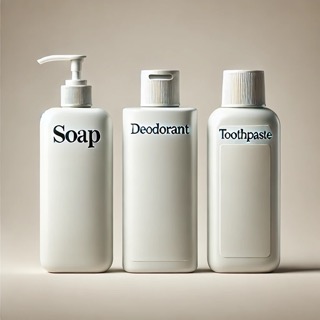
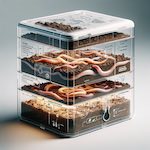
_water_filter_system2.jpg)
